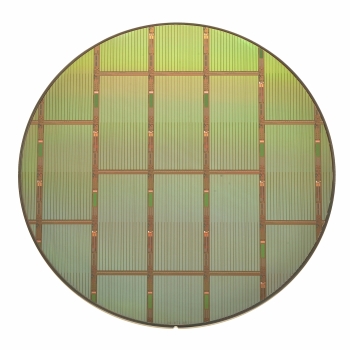
Laboratory cameras are enabling TESS’s quest for exoplanets
On April 18, the much-anticipated Transiting Exoplanet Survey Satellite (TESS) was successfully launched from Cape Canaveral, Florida, on a SpaceX Falcon 9. The satellite set off on a two-year mission to search the cosmos for nearby exoplanets. TESS will survey 85 percent of the sky, encompassing more than 20 million stars, looking for dips in a star’s brightness — a sign that a planet may be passing in front of the star during orbit. After identifying these exoplanets, researchers will then delve deeper to characterize their atmospheres and masses, and hopefully discover any telltale signs of habitability.
TESS is a NASA-funded mission developed collaboratively with the NASA Goddard Space Flight Center. Central to the TESS mission are the four charge-coupled-device (CCD) cameras that were developed jointly by the Laboratory and MIT’s Kavli Institute for Astrophysics and Space Research. A team of researchers at the Laboratory, spearheaded by TESS Instrument Manager Gregory Berthiaume, who is the leader of the Space Systems Analysis and Test Group, built the imaging devices and lenses using unique Laboratory capabilities. More than 100 employees across multiple R&D areas at the Laboratory contributed to the program.
Vyshnavi Suntharalingam, a senior staff member in the Applied Space Systems Group and CCD lead for the TESS project, explained how the imaging devices were customized to meet the TESS mission’s needs. Because a dip in brightness caused by a planet passing by a star is faint, and the stars themselves are bright, “the devices have to handle a large dynamic range; they need to have low noise but also be able to handle very bright signals across the spectral band,” Suntharalingam said. Noise occurs when a device’s own features introduce signal variations that can overwhelm a weaker external signal, such as subtle changes in a star’s brightness. “The devices also need to be very large and uniform in performance to meet the requirements of the all-sky survey.”
To meet these needs, the research team utilized the advanced capabilities of the Laboratory's Microelectronics Laboratory to fabricate large-format imaging devices and to obtain high photon-collection through back-illumination processing. Using special thermal cycles to minimize defects and charge traps, the research team fabricated the devices on very high-purity semiconducting silicon wafers. Eight devices are fabricated on a wafer, and each device contains a top and bottom half. The top half collects light (imaging array) while the bottom half stores it (frame store), and they are “stitched” together with nanometer precision to align the four-million pixels in each of the two halves. The end result is a 6.4 cm × 3.2 cm chip.
Daniel Pulver, the manager of the Microelectronics Laboratory, said that the project benefited from the facility's advanced capability to fabricate wafers of 200 mm diameter. “I’m happy we got to work on the project and that TESS launched successfully,” said Pulver. “Pretty soon we’re expecting to know if the cameras are actually working up in space.”
In addition to the imaging devices, the Laboratory also created the large-aperture, wide-angle lenses for the cameras that accommodate the devices. “They are designed to achieve the best possible performance for red dwarf stars over the 24-degree-by-24-degree field of view,” explained Anthony Smith, TESS deputy program manager. The type of stars that TESS is searching for are red dwarfs, which primarily emit longer wavelengths of light. “One of the lens elements is coated with a filter coating that blocks shorter wavelength light — ultraviolet, blue, green, yellow, and orange. Blocking short wavelengths helps optimize sensitivity for red dwarfs.”

Many Laboratory staff who worked on the cameras attended the launch in Cape Canaveral, Florida.
“To me, the rocket looked like a bright candle flaring off. It was incredibly moving to see it turn and get fainter and fainter into the sky,” said Suntharalingam. “The success of the reusable Falcon 9 launch system was really impressive.”
“Watching a launch that contains something that you have invested so much time and energy in is a bit like watching your child get on the bus on the very first day of kindergarten — excitement mixed with a healthy dose of unease,” said Renee Lambert, the back-illumination fabrication process lead on the project. “I have loved working on TESS and can’t wait to see what it might help to discover.
On May 30, TESS underwent a final thruster burn to enter its science orbit around Earth. The four CCD cameras have been functioning normally and are collecting data for the calibration process, which takes place throughout June.
TESS is a NASA Astrophysics Explorer mission led and operated by MIT in Cambridge, Massachusetts, and managed by NASA’s Goddard Space Flight Center in Greenbelt, Maryland. George Ricker of MIT’s Kavli Institute for Astrophysics and Space Research serves as principal investigator for the mission. Additional partners include Northrop Grumman, based in Falls Church, Virginia; NASA’s Ames Research Center in California’s Silicon Valley; the Harvard-Smithsonian Center for Astrophysics in Cambridge, Massachusetts; MIT Lincoln Laboratory in Lexington, Massachusetts; and the Space Telescope Science Institute in Baltimore. More than a dozen universities, research institutes, and observatories worldwide are participants in the mission.
